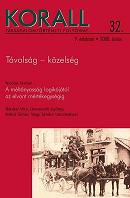Piszkos perek. Családi konfl iktus a jog útvesztőjében (1882–1893)
Dirty Lawsuits: Family Conflict in the Maze of Law (1882–1893)
Author(s): Sándor NagySubject(s): History
Published by: KORALL Társadalomtörténeti Egyesület
Summary/Abstract: This essay, as a peculiar continuation to Vera Bácskai’s article, examines the legal aspect of a family conflict, which took place in both parts of the Austro-Hungarian Monarchy in the latter third of the nineteenth century. The story itself is that of the disintegration of the family of the Saxon-Hungarian soldier baron who had seduced and married the daughter of a Viennese Greek merchant. It reports the efforts of the husband and his wife, disowned by her father, to secure her inheritance, and later on, the ruin of their marriage and the subsequent criminal case of adultery starting in Görz (Gorizia, Austria), continuing in Budapest, and culminating in a scandalous divorce case in Cluj. (Kolozsvár, Hungary) The essay, however, focuses less on the actual story, and more on the relationships between different legal procedures, the choice of legal strategies and tactics of the family members, the underlying motivations, and the consequences of their decisions. The justification of this choice, which is also one of the most important conclusions of this essay, is that the source expected to help us reconstruct the confl ict, the narratives of the participants and their witnesses presented in courts of the Austro-Hungarian Monarchy conform these aforementioned strategies entirely. According to the author, a case of pathological legal practice, in some respects, sheds more light on the operation of the contemporary legal system than ’normal’ legal cases. In this case, family members consciously (ab)use the conflicting Austro-Hungarian (as well as Hungarian vs Transylvanian) laws and fully exploit the possibilities that these conflicts opened up for them in order to achieve their goals. This manoeuvring in the given legal context increases the importance of questions of adjective law, arising from the status of the subjects (citizenship/national status, place of residency, religion). At the same time it ’impersonalized’ the legal conflict for the participants, in that determining the tactics were entirely taken over by professional representatives and lawyers instead of the parties involved. Analysis in this particular case stresses the intimate relationship between lawsuits and administrative procedures. The modality of the criminal lawsuit of adultery and the divorce case (examined in greater depth due to the nature of source material available) is fundamentally determined by the struggle for the inheritance. Ultimately, especially following the estrangement of the couple, the legal conflict lost its ’rational’ characteristics, ruined the social prestige of the families involved, and irreversibly destroyed all human bonds between the members of the family. Thus, no matter how resourceful individual legal practices were in this case, beyond a certain point (and one that is hard to define) the institutionalized administration of justice made the irreconcilable parties pay a high price. The author also draws attention to a possible, and in this partic
Journal: Korall - Társadalomtörténeti folyóirat
- Issue Year: 2008
- Issue No: 32
- Page Range: 100-131
- Page Count: 32
- Language: Hungarian

